
The Staatliches Bauhaus, commonly known as the Bauhaus, was a German art school operational from 1919 to 1933 that combined crafts and the fine arts. The school became famous for its approach to design, which attempted to unify the principles of mass production with individual artistic vision and strove to combine aesthetics with everyday function.
Bruno Nettl was an ethnomusicologist who was central in defining ethnomusicology as a discipline. His research focused on folk and traditional music, specifically Native American music the music of Iran and numerous topics surrounding ethnomusicology as a discipline.

Bruno Julius Florian Taut was a renowned German architect, urban planner and author of Prussian Lithuanian heritage. He was active during the Weimar period and is known for his theoretical works as well as his building designs.
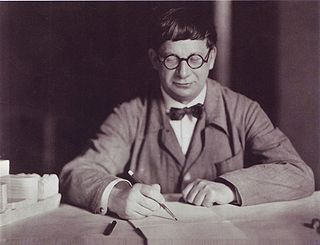
Hans Poelzig was a German architect, painter and set designer.

Mart Stam was a Dutch architect, urban planner, and furniture designer. Stam was extraordinarily well-connected, and his career intersects with important moments in the history of 20th-century European architecture, including the invention of the cantilever tubular chair, teaching at the Bauhaus, contributions to the Weissenhof Estate, the Van Nelle Factory,, buildings for Ernst May's New Frankfurt housing estates, followed by work in the USSR with the idealistic May Brigade, to teaching positions in Amsterdam and post-war East Germany. Upon return to the Netherlands he contributed to postwar reconstruction and finally retired,, in Switzerland, where he died.

Expressionist architecture was an architectural movement in Europe during the first decades of the 20th century in parallel with the expressionist visual and performing arts that especially developed and dominated in Germany. Brick Expressionism is a special variant of this movement in western and northern Germany, as well as in the Netherlands.
The Glass Chain or Crystal Chain sometimes known as the "Utopian Correspondence" was a chain letter that took place between November 1919 and December 1920. It was a correspondence of architects that formed a basis of expressionist architecture in Germany. It was initiated by Bruno Taut.
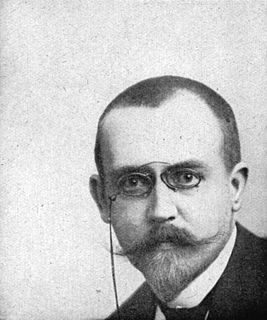
Paul Karl Wilhelm Scheerbart was a German author of speculative fiction literature and drawings. He was also published under the pseudonym Kuno Küfer and is best known for the book Glasarchitektur (1914).

The Weissenhof Estate is a housing estate built for the Deutscher Werkbund exhibition in Stuttgart in 1927. It was an international showcase of what later became known as the International style of architecture. Two of the buildings were designed by the French-Swiss architect Le Corbusier and these are now part of the World Heritage Site The Architectural Work of Le Corbusier, an Outstanding Contribution to the Modern Movement, which was designated in 2016. The World Heritage Site consists of 17 separate sites in seven countries. For the Weissenhof Estate, only Le Corbusier's houses are part of World Heritage Site itself: the remainder of the Weissenhof Estate and some adjacent streets and buildings, a surface of 33.6213 ha (3,618,970 sq ft), are however part of the World Heritage Site's buffer zone.

Adolf Behne was a critic, art historian, architectural writer, and artistic activist. He was one of the leaders of the Avant Garde in the Weimar Republic.
The Arbeitsrat für Kunst was a union of architects, painters, sculptors and art writers, who were based in Berlin from 1918 to 1921. It developed as a response to the Workers and Soldiers councils and was dedicated to the goal of bringing the current developments and tendencies in architecture and art to a broader population.
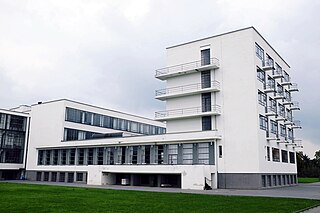
The New Objectivity is a name often given to the Modern architecture that emerged in Europe, primarily German-speaking Europe, in the 1920s and 30s. It is also frequently called Neues Bauen. The New Objectivity remodeled many German cities in this period.
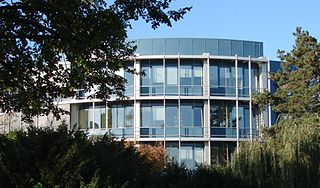
Thieme Medical Publishers is a German medical and science publisher in the Thieme Publishing Group. It produces professional journals, textbooks, atlases, monographs and reference books in both German and English covering a variety of medical specialties, including neurosurgery, orthopaedics, endocrinology, urology, radiology, anatomy, chemistry, otolaryngology, ophthalmology, audiology and speech-language pathology, complementary and alternative medicine. Thieme has more than 1,000 employees and maintains offices in seven cities worldwide, including New York City, Beijing, Delhi, Stuttgart, and three other cities in Germany.
Berlin Modernism Housing Estates is a World Heritage Site designated in 2008, comprising six separate subsidized housing estates in Berlin. Dating mainly from the years of the Weimar Republic (1919–1933), when the city of Berlin was particularly progressive socially, politically and culturally, they are outstanding examples of the building reform movement that contributed to improving housing and living conditions for people with low incomes through innovative approaches to architecture and urban planning. The estates also provide exceptional examples of new urban and architectural typologies, featuring fresh design solutions, as well as technical and aesthetic innovations.
Carl Christian Krayl was a German architect and artist of the early twentieth century, who was associated with several of the leading avant-garde art movements of German Expressionism.
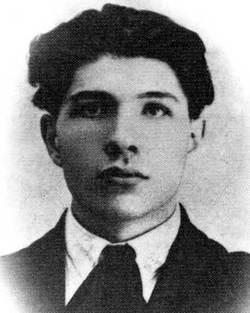
Bruno Filippi was an Italian individualist anarchist writer and activist who collaborated in the Italian individualist anarchist magazine Iconoclasta! alongside Renzo Novatore.

Markus Breitschmid is a Swiss-American architectural theoretician and the author of several books on contemporary architecture and philosophical aesthetics. His most highly regarded books are Der bauende Geist. Friedrich Nietzsche und die Architektur (2001), The Significance of the Idea' The Architecture of Valerio Olgiati, and Non-Referential Architecture. His writings have been translated into Chinese, English, French, German, Hindi, Italian, Japanese, Korean, Russian, and Spanish. Breitschmid has been invited to contribute to the Venice Biennale of Architecture, the Architecture Biennale of Chicago, and the Triennale of Architecture in Lisbon. Breitschmid, together with the architect Valerio Olgiati, has introduced the term Non-Referential Architecture into the architectural discourse.

The Hufeisensiedlung is a housing estate in Berlin, built in 1925–33. It was designed by architect Bruno Taut, municipal planning head and co-architect Martin Wagner, garden architect Leberecht Migge and Neukölln gardens director Ottokar Wagler. In 1986 the ensemble was placed under German heritage protection. On 7 July 2008 it was inscribed as one of six estates that constitute the Berlin Modernism Housing Estates World Heritage Site.
Franz Hillinger was an architect of the Neues Bauen movement in Berlin and in Turkey.

The Hotel Rosita De Hornedo, located in the Puntilla area of Miramar, was one of the first major buildings to be built by a private developer in the 1950s in Havana.













